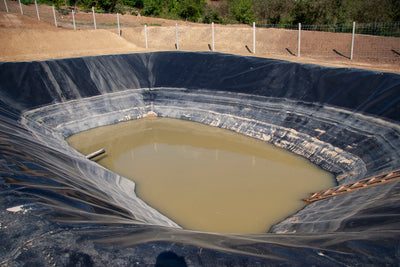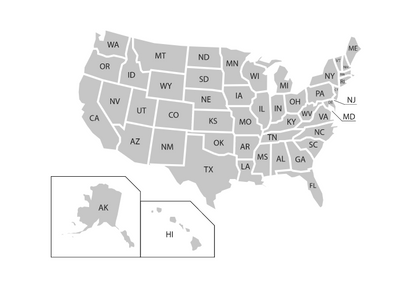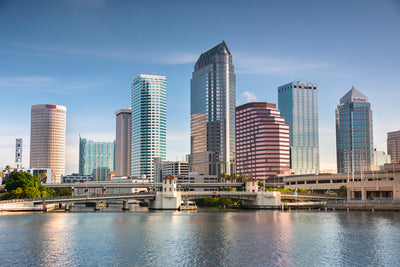Water Quality InformationWritten By Actual Experts
RSSDrinking Water Supplies Risk Contamination from Toxic Wastewater Ponds

Is Your City In NRDC's Latest Lead Contamination Report?

Christina Liu | Scientific Contributor
The Natural Resources Defense Council (NRDC) released a recent analysis of EPA lead data. NRDC found that 186 million people across the United States were exposed to elevated lead levels through their drinking water systems.The EPA, CDC and the American Academy of Pediatrics all recognize that there is no safe level of lead for children. This article breaks down important findings from this study and what they mean for your drinking water.
1. Lead in Drinking Water Is a Significant Issue in Many Parts of the Country
- 186 million people in the United States between January 1, 2018 and December 31, 2020 drank water that exceeded the pediatrician recommended maximum lead level of 1 part per billion (ppb).
- 28 million people were served by drinking water systems that totaled 12,892 lead violations.
- Seven million people drank water that exceeded EPA’s Lead Action Level of 15 ppb.
- The CDC and the American Academy of Pediatrics have stated that there is no safe level of lead for young children. The EPA has also set the maximum contaminant level goal (MCLG) for lead in drinking water at 0 parts per billion because lead can be harmful to human health even at low exposure levels.
2. Do Federal Laws Protect You From Lead Exposure in Drinking Water?
Unfortunately, no. The Lead and Copper Rule (LCR) was first enacted in 1991 and has seen minimal changes since then. It is the only major regulation aimed at protecting the public from lead exposure in drinking water. It does however contain loopholes, exemptions, and regulatory flaws which demonstrate that the LCR does not necessarily prioritize human health. The most obvious and deceptive flaw is the 90th percentile rule, which states that only 90% of samples must meet EPA’s 15 part per billion “Action Level (AL)” threshold. This means that 10% of samples can exceed the AL threshold and still be in compliance with the law.
3. My Water Source is Completely Clean. Do I Still Have To Worry About Lead?
Lead contaminates tap water differently than most pollutants, because lead comes from plumbing - not the water supply. Water leaving the treatment plant can be entirely lead-free but becomes contaminated once it hits older infrastructure. For example, some buildings in older neighborhoods have lead-containing service pipes that connect water mains to the residential plumbing, and plumbing installed before 1986 often used lead-containing solder to join copper pipes. If corrosion control measures fail (what happened in Flint, MI), lead can leach from the pipes into the tap water. This problem is exacerbated when water sits stagnant for several hours before use (e.g. overnight or while resident is at work), because lead concentrations rise as corrosive water sits in the pipes.
Case Study: New York City
New York City provides municipal tap water for more than half the population of New York, through an impressive network of 19 reservoirs and 3 lakes. New York City’s tap water is widely recognized in the water industry as the “Gold Standard” for urban water providers (it’s truly an engineering feat on an unimaginable scale). However, even if the water leaves the reservoirs and water plants lead-free, lead contamination occurs when the water encounters aging pipes and connections that contain lead. In the table below you’ll notice several samples are well over the federal Action Level - some are over 300 times higher than the 15 part per billion threshold.
Table 1. New York City lead levels from 2007 - 2022
4. Does The American Jobs Infrastructure Plan Go Far Enough To Reduce Lead Exposure?
The American Jobs Plan includes $111 billion in funding for water infrastructure. $45 billion of this is being allocated to eliminate ALL lead pipes and service lines. That is a significant promise, but not a lot of money with which to accomplish this. An estimated 6-10 million homes in the U.S. still receive their drinking water from a lead pipe or lead service line. In addition, the process of replacing city-wide distribution lines will be invasive and time-consuming. It involves digging up streets, section by section, across an entire city. Individual homeowners also need to hire a specialist to replace their lead service lines to avoid potential exposure to this known neurotoxin. Also, lead levels increase for the first few months after a service line is replaced. We have an article that goes in depth as to why this is, which you can find here. Unfortunately, if you currently have lead service lines that bring water to your home, while you may experience relief (new pipes) in the future, this won’t be an immediate fix.
What can I do?
-
Get informed. Look up the water quality report in your area. See if your water supplier is one of the ones mentioned in the NRDC study. Information on lead in drinking water, testing methods, and steps you can take to minimize exposure is available from the Safe Drinking Water Hotline or on the EPA’s page: Basic Information about Lead in Drinking Water.
-
Get your water tested for lead. Many cities have free lead testing kits or lead testing services. Check your city’s website or water quality report for information. Please take advantage of these resources if they are available to you.
-
Flush your tap before using water for consumption. If your water has been sitting for over six hours, minimize the potential for lead exposure by flushing your tap for a minimum of 5 minutes before using water for drinking or cooking.
-
Use cold water. Use only cold water for drinking, cooking and making baby formula. Hot tap water is known to cause lead to leach from your home's pipes.
-
Check your Filters. If you are using a filter for your drinking water, please verify that it is certified for lead removal.
How Can Hydroviv Help Me?
Hydroviv is a water filtration company that uses water quality data to optimize water filters for each customer's water. In addition to lead, we use the water quality data for each location to determine what we consider to be major “points of emphasis” that we use to build water filters that are built specifically for municipal water in your area as well as for private wells.
If you’re interested in learning more about water filters that have been optimized for your municipal tap water or private well, or just have questions about water quality in general, feel free to visit www.hydroviv.com, reach out by email (hello@hydroviv.com) or through our live chat. We post water-related news on Twitter, Instagram, and Facebook.
Hydroviv's drinking water filters carry NSF certifications to Standard 42 (aesthetic effects--Chlorine Removal) and Standard 53 (health effects--Lead, VOCs, and PFOA/PFOS removal), and are independently tested to remove hundreds of contaminants.
Other Articles We Think You Might Enjoy:
PFAS and The Safe Drinking Water Act
Disinfection Byproducts in Drinking Water: Toxicity, History, and Policy
Does Boiling My Water Purify It?
Drinking Water Problems in the Tampa Bay Region of Florida

Christina Liu, B.S. | Hydroviv Science Team
Tampa Bay Water is an alliance between the six governments in west-central Florida: Hillsborough County, Pasco County, Pinellas County, New Port Richey, St. Petersburg and Tampa. These municipalities, in turn, provide drinking water to more than 2.5 million people in the Tampa Bay region. For Hydroviv’s assessment of Tampa Bay Region’s drinking water, we aggregated water quality test data from Tampa Bay Water, the 6 municipal suppliers listed above, the U.S. Environmental Protection Agency (EPA), the Environmental Working Group, and the US Geological Survey. Our Water Nerds then cross referenced these data with toxicity studies in the scientific and medical literature, as well as upcoming regulatory changes. The custom water filters that we build for our customers in the Tampa Bay Region are optimized with this research in mind.
Source of the Tampa Bay Region’s Drinking Water
Tampa Bay Water’s supply is a blend of treated groundwater, river water and desalinated seawater. Groundwater comes from 12 wellfields pumping water from the Floridan Aquifer. River water is withdrawn from the Alafia River, Hillsborough River and the Tampa Bypass Canal. Surplus river and canal water is stored in the C.W. Bill Young Regional Reservoir, which supplies the surface water treatment plant during dry times. Hillsborough Bay is the source of seawater for the Tampa Bay Seawater Desalination Plant.
What Are The Major Concerns in Tampa Bay Drinking Water?
Contaminants of concern in the Tampa Bay Region’s drinking water include Lead, PFAS, Disinfection Byproducts, Radium, and Uranium. Low amounts of Arsenic and Chromium 6 were also detected in the water. Chloramine is used to disinfect the water.
Lead In Tampa Bay Region’s Drinking Water
Lead enters into the consumer's tap water through old lead service pipes and lead-containing plumbing. When corrosion control measures fail (as witnessed in Flint, Michigan), lead leaches into the drinking water, reaching toxic levels. 2020 lead sampling by Tampa Bay Water detected levels as high as 4 parts per billion. EPA, CDC and the American Academy of Pediatrics all recognize that there is no safe level of lead for children. In addition, Federal regulations cannot take into account levels measured at an individual tap.
PFAS or 'Forever Chemicals' in Tampa Bay Water
Per and Polyfluoroalkyl Substances (PFAS) are a category of emerging contaminants commonly used in firefighting foam, Teflon, non-stick surfaces, stain-resistant surfaces, and food packaging. The Agency for Toxic Substances and Disease Registry (ATSDR) has determined that PFAS exposure is associated with various adverse health effects, including an increased risk of cancer, lowered fertility rates, and developmental issues in infants and young children. A new study out of The Yale School of Public Health recently found that exposure to PFAS increases the risk of miscarriage by 80-120% in pregnant women. The Centers for Disease Control also issued a disclosure regarding a potential intersection between PFAS and COVID-19.
Even small amounts of PFAS are extremely toxic. PFAS are measured in parts per trillion, and one part per trillion is equivalent to one drop of water in 20 Olympic-sized swimming pools.
PFAS have been detected in a growing number of municipalities across the United States. Most municipalities are not required to test for or remove PFAS from drinking water, including the Tampa Bay Region. Not all water filters are designed to remove PFAS from tap water. If you'd like to find water filters that remove PFAS from tap water, check out this Duke/NC State PFAS study. Hydroviv filters are NSF/ANSI Standard 53 certified for PFOA/PFOS removal.
Disinfection Byproducts (DBPs) In Tampa Bay Drinking Water
DBPs are a category of emerging contaminants that form when chlorine-based disinfectants (added to the water supply to protect consumers) react with naturally-occurring organic matter. EPA regulates two categories of DBPs: Total Trihalomethanes (TTHMs) and Haloacetic Acids (HAA5). The EPA has stated that DBPs have been associated with increased risk of bladder cancer, as well as kidney, liver, and central nervous system problems. Haloacetic Acid levels in Hillsborough and Pinellas County ranged as high as 47.2 parts per billion, nearing the EPA Maximum Contaminant Level of 60 parts per billion. Total Trihalomethane levels ranged as high as 107 parts per billion, exceeding the EPA Maximum Contaminant Level of 80 parts per billion.
Radium and Uranium in Tampa Bay Region’s Drinking Water
Radium is formed when uranium and thorium undergo radioactive decay in the environment. Two of the main radium isotopes found in the environment are radium-226 and radium-228. Radium in drinking water is of primary concern because this radiation may cause cancer, kidney damage and birth defects. Radium levels in Hillsborough County were as high as 2.04 ppb with the EPA Maximum Contaminant Level Goal 5 ppb. Uranium levels in Pasco County water measured at 0.54 ppb in 2019, with the EPA Maximum Contaminant Level Goal set at 30 ppb.
Use Of Chloramine In Tampa Bay Region’s Tap Water
While most cities use chlorine as the primary disinfectant, all of the municipalities within Tampa Bay Water use chloramine, which is made by combining chlorine and ammonia. Chloramine is frequently the issue when customers report a “bad taste” in their tap water, and unlike chlorine will not fade away if left in the fridge overnight. The 2020 chloramine running annual average for the City of Tampa Bay was 3.5 parts per million, with samples ranging as high as 5.3 ppm; the maximum residual disinfectant level, in comparison, is only 4.0 ppm. Most one-size-fits-all water filters use filtration media that don’t adequately remove chloramine, but the filters that Hydroviv builds for Tampa Bay Area water use special filtration media that are purpose-built to remove chloramine as well.
Arsenic in Tampa Bay Region’s Drinking Water
Arsenic is a hazardous heavy metal that can cause cancer and other health problems. Arsenic originates in source water naturally. In the Tampa Bay Water region, low amounts of arsenic were detected in the different areas, ranging from 0.11 ppb to 0.43 ppb. While Tampa Bay Region’s Arsenic levels were comparatively low when measured to EPA water quality standards, consumers should know that the U.S. EPA's standard balances toxicity against the costs of removing arsenic from drinking water.
Chromium 6 Levels In Tampa Bay Region’s Drinking Water
Chromium 6 is a highly toxic metal that is not regulated by the EPA. Tampa Bay Water was measured to have Chromium 6 levels ranging from 47 parts per trillion to 140 parts per trillion. California has determined that 20 parts per trillion is the contaminant level below which there is minimal health risk. The Chromium 6 levels in the Tampa Bay water system range from about 2 to 7 times the level generally accepted as safe.
How Can Hydroviv Help Me?
Hydroviv is a water filtration company that uses water quality data to optimize water filters for each customer's water. The contaminants that we list above are what we consider to be major “points of emphasis” that we use to build water filters that are built specifically for Tampa Bay Area water, but all of our filters also include broad protection against a wide range of contaminants.
If you’re interested in learning more about water filters that have been optimized for Tampa Bay tap water, or just have questions about water quality in general, feel free to visit www.hydroviv.com, reach out by email (hello@hydroviv.com) or through our live chat. We post water-related news on Twitter, Instagram, and Facebook.
Hydroviv's drinking water filters carry NSF certifications to Standard 42 (aesthetic effects--Chlorine Removal) and Standard 53 (health effects--Lead, VOCs, and PFOA/PFOS removal), and are independently tested to remove hundreds of contaminants.
Recommended Articles For You:Everything You Need To Know About PFAS Contamination in Tap Water
Disinfection Byproducts In Your Drinking Water
Problems We Found With Orlando Drinking Water
Drinking Water Issues in the East Bay Region of California

Christina Liu, B.S. | Hydroviv's Science Team
For Hydroviv’s assessment of East Bay MUD’s drinking water, we aggregated water quality test data from EBMUD, the U.S. Environmental Protection Agency (EPA), the Environmental Working Group, and the US Geological Survey. Our Water Nerds then cross referenced these data with toxicity studies in the scientific and medical literature, as well as upcoming regulatory changes. The custom water filters that we build for our customers in the East Bay Region of California are optimized with this research in mind.
Who Gets Drinking Water From The East Bay Municipal Utility District?
The East Bay Municipal Utility District (EBMUD) serves 1.4 Million customers in the East Bay Region of California, including the cities of Crockett, Rodeo, Hercules, Pinole, El Sobrante, San Pablo, Richmond, El Cerrito, Kensington, Orinda, Moraga, Piedmont, Oakland, Alameda, San Leandro, San Lorenzo, Castro Valley, Hayward, Albany, Berkeley, Emeryville, Lafayette, Pleasant Hill, Walnut Creek, Alamo, Danville, and San Ramon.
Source Water for EBMUD
The 577-square mile Mokelumne River watershed on the western slope of the Sierra Nevada is the major source of the water used by the East Bay customers. Snowmelt from Alpine, Amador, and Calaveras counties flows into Pardee Reservoir near Valley Springs. Three large aqueducts transport water 90 miles from Pardee Reservoir into EBMUD’s water distribution system.
Lead In East Bay’s Drinking Water
Lead enters into the consumer's tap water through old lead service pipes and lead-containing plumbing. When corrosion control measures fail (as witnessed in Flint, Michigan), lead leaches into the drinking water, reaching toxic levels. EBMUD conducted lead sampling of schools in their service area between 2017 and 2020. EBMUD reported results of less than 5 ppb in 95 percent of the samples and less than 1 ppb in 77 percent of the samples. Please bear in mind that EPA, CDC and the American Academy of Pediatrics all recognize that there is no safe level of lead for children. In addition, Federal regulations also cannot take into account levels measured at an individual tap.PFAS in East Bay’s Drinking Water
Per and Polyfluoroalkyl Substances (PFAS) are a category of emerging contaminants commonly used in firefighting foam, Teflon, non-stick surfaces, stain-resistant surfaces, and food packaging. The Agency for Toxic Substances and Disease Registry (ATSDR) has determined that PFAS exposure is associated with various adverse health effects, including an increased risk of cancer, lowered fertility rates, and developmental issues in infants and young children. A new study out of The Yale School of Public Health recently found that exposure to PFAS increases the risk of miscarriage by 80-120% in pregnant women. The Centers for Disease Control also issued a disclosure regarding a potential intersection between PFAS and COVID-19.
Even small amounts of PFAS are extremely toxic. PFAS are measured in parts per trillion, and one part per trillion is equivalent to one drop of water in 20 Olympic-sized swimming pools.
PFAS have been detected in a growing number of municipalities across the United States. Several years ago, the USEPA required large water systems (including EBMUD) to collect and analyze samples for a limited set of PFAS, and the CA State Water Board has issued monitoring orders to hundreds of water systems most vulnerable to PFAS contamination due to their proximity to airports with fire training and response areas and municipal solid waste landfills. While EBMUD was not required to monitor due to the protected nature of their watersheds, but they performed a voluntary collection and analyzed samples from their treatment plants during 2020. Low levels were detected in the water -- 5.1 parts per trillion for PFOA and 6.5 parts per trillion for PFOS. Not all water filters are designed to remove PFAS from tap water. If you'd like to find water filters that remove PFAS from tap water, check out this Duke/NC State PFAS study. Hydroviv filters are NSF/ANSI Standard 53 certified for PFOA/PFOS removal.
Disinfection Byproducts (DBPs) In East Bay’s Drinking Water
DBPs are a category of emerging contaminants that form when chlorine-based disinfectants (added to the water supply to protect consumers) react with naturally-occurring organic matter. EPA regulates two categories of DBPs: Total Trihalomethanes (TTHMs) and Haloacetic Acids (HAA5). The EPA has stated that DBPs have been associated with increased risk of bladder cancer, as well as kidney, liver, and central nervous system problems. Haloacetic Acid levels in ranged as high as 51 parts per billion, nearing the EPA Maximum Contaminant Level of 60 parts per billion. Total Trihalomethane levels ranged as high as 57 parts per billion, as compared to the EPA Maximum Contaminant Level of 80 parts per billion.
Chromium 6 Levels In East Bay’s Drinking Water
Chromium 6 is a highly toxic metal that is not regulated by the EPA. EBMUD was measured to have Chromium 6 levels measuring as high as 220 parts per trillion. California has determined that 20 parts per trillion is the contaminant level below which there is minimal health risk. The Chromium 6 levels in East Bay’s Water were as high as 11 times the level generally accepted as safe.
Use Of Chloramine In East Bay’s Tap Water
While most cities use chlorine as the primary disinfectant, all of the municipalities within EBMUD use chloramine, which is made by combining chlorine and ammonia. Chloramine is frequently the issue when customers report a “bad taste” in their tap water, and unlike chlorine will not fade away if left in the fridge overnight. The 2020 chloramine running annual average for EBMUD was 2.4 parts per million, with samples ranging as high as 4 ppm, which is the maximum residual disinfectant level. Most one-size-fits-all water filters use filtration media that don’t adequately remove chloramine, but the filters that Hydroviv builds for water provided by EBMUD use special filtration media that are purpose-built to remove chloramine as well.
How Can Hydroviv Help Me?
Hydroviv is a water filtration company that uses water quality data to optimize water filters for each customer's water. The contaminants that we list above are what we consider to be major “points of emphasis” that we use to build water filters that are built specifically for East Bay’s water, but all of our filters also include broad protection against a wide range of contaminants.
If you’re interested in learning more about water filters that have been optimized for East Bay tap water, or just have questions about water quality in general, feel free to visit www.hydroviv.com, reach out by email (hello@hydroviv.com) or through our live chat. We post water-related news on Twitter, Instagram, and Facebook.
Hydroviv's drinking water filters carry NSF certifications to Standard 42 (aesthetic effects--Chlorine Removal) and Standard 53 (health effects--Lead, VOCs, and PFOA/PFOS removal), and are independently tested to remove hundreds of contaminants. Please Share This East Bay Water Quality Article With Anyone You Think Would Benefit From The Information!
Recommended Articles For YouEverything You Need To Know About PFAS Contamination in Tap Water
Disinfection Byproducts In Your Drinking Water
5 Things to Know about Chromium-6 in Drinking Water
Problems We Found in San Francisco, California Drinking Water
Recent Legislation Aims to Tackle Coal Ash Pollution







